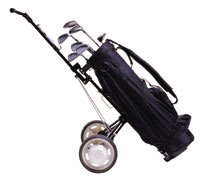
This state-of-the-art report shows how polarized lenses have evolved into the growing category they are today.
By Joseph L. Bruneni
Sunwear consumers have been attracted to polarized sunglasses for well over 60 years. The first lenses, produced by American Optical, were plano and sold in drug stores.
By today's standards, these 1930's products were crude. The first oddity was that the lenses were made from thin sheets of flat glass, with the polarizing film sandwiched in the middle. They were flat because no one knew how to shape polarizing film to match the normal curve of ophthalmic lenses.
A new concept, the first polarized sunglasses were priced around $5.00 to consumers. For those dreary Depression times, this was an outrageous price for over-the-counter sunglasses. Nevertheless, Polaroid sunglasses became successful for much the same reason they are so popular today-they performed an action that was immediately evident.
Early Shortcomings
There were more than a few disadvantages to those primitive polarized sunglasses, but they sold well in spite of them. Their shortcomings follow.
|
Tips for Processing Polarized Lenses |
|
| Here are some guidelines to consider when processing polarized product.
Drilling. Polarized lenses require no special care for drilling, beveling, or grooving. Tinting. Polarized lenses can be tinted like any other plastic lens. Avoid over-heating. Edging. When edging, it's critical to properly align the polarizing filter. Manufacturers place markings on the lens to indicate the 180� line to be used when laying out lenses for edging. Sizing. After beveling, lenses should be sized for a snug fit, not a tight fit. n Alignment. After mounting, verify that the polarizing filter is properly aligned to the 180� line. Coatings. Polarized lenses can be mirror coated as well as AR coated. |
|
Breakage. The two laminated sheets of glass were approximately 1mm thick and, in those pre-FDA days, were not tempered. As a result, a little pressure on the frame would crack one of the wafers. The lenses remained in one piece, held together by the film, and looking through a cracked lens turned out to be a common annoyance.
Separation. The laminating process used for those early lenses was crude, and it wasn't unusual for wearers to find a whitish area creeping in from one edge of a lens as film and wafer separated.
Cost. Over-the-counter sunglasses sold for less than a dollar, and $5.00 polarized sunwear was considered expensive.
Optics. As you might imagine, viewing the world through flat lenses created serious distortions when looking anywhere but through the exact center of the lens.
Cosmetics. Due to the lamination process, the original glass polarized lenses ended up considerably thicker than conventional glass lenses. The minimum thickness for each wafer was 1.0mm, so finished lenses were at least 2.0mm thick at their thinnest point. This made for heavy, thick lenses at a time when minus glass lenses were often less than 1.0mm center thickness.
Modern Polarized Lenses
Polarized lenses have come a long way since the 1930s. For the balance of this article, we'll review the current state of polarized technology and review how modern polarized lenses have improved on the factors listed above.
Breakage. This is a relatively minor problem for glass polarized lenses today. FDA regulations do not require laminated glass lenses to be heat-treated or tempered. The FDA's reasoning is that, for safety purposes, the film in a laminated lens holds broken pieces together and prevents glass particles from impacting eyes. Plastic polarized lenses, of course, are much more impact resistant than glass, so breakage is seldom a problem with modern plastic polarized lenses.
Separation. The manufacturers of plastic lenses now treat the polarizing film with adhesive and suspend the film in the mold during casting. This essentially produces a one-piece lens and eliminates the old problem of separation between film and lens wafer. Glass polarized lenses are still produced in a lamination process, but advances in adhesives and molecular chemistry have made separation in polarized glass a thing of the past. As a comfort factor for dispensers, most manufacturers warranty their polarized lenses against delamination.

Optics. Compromised optics are simply not an issue with modern polarized lenses. Many of the world's finest lens designs are now available in polarized form, and they share the same precise optics as conventional lenses. Quality polarized sun lenses unquestionably represent the finest quality in ophthalmic lenses, and they're now available in single vision, several forms of bifocals and trifocals, as well as brand-name progressives.
Cosmetics. In this area, polarized lenses have really come of age. Placement of the film during manufacturing used to be a rather random process, with the film usually ending up somewhere about 1.0mm behind the front surface of the lens. As the quest for thinner, lighter eyewear became a cosmetic issue for lenses, however, labs faced a problem in processing polarized lenses. The one guaranteed way to ruin a polarized lens is to grind into the filter portion, particularly with minus corrections. Surface a fraction of a millimeter too much off the backside of the lens and a highly visible white spot appears in the center. To avoid this problem, labs tended to surface polarized lenses slightly thicker.
Polarized lens producers now control film placement more precisely. For one thing, the polarizing film is individually curved to match the exact shape of the front curve, varying with the base curve. This more precise matching of filter to lens curve allows labs to process polarized lenses to conventional thicknesses. At least one manufacturer has found a way to position film in its lenses just behind the front surface, and these lenses can be surfaced routinely to 1.5mm minimum thickness (edge or center, depending on if plus or minus).
One of the more popular forms of polarized sunlenses is made of polycarbonate. The film is placed inside the front mold before the poly is injected into it. This produces a superior bond between film and lens blank. As a result, labs can process polarized poly as thin as 1.0mm. That provides the thinnest polarized lenses currently available. Heat created during injection molding does, however, slightly reduce the polarizing efficiency.
|
|
For Additional Information... |
|
If you're looking to learn more about the polarized category and the products available, check out the following Websites: KBco: www.kbco.net Specialty Lens Corporation: www.specialtylens.com Vision-Ease Lens: www.vision-ease.com Younger Optics: www.youngeroptics.com |
Polarized Benefits
Any quality sunlens will reduce harsh sunlight to acceptable levels and provide added comfort to the wearer. The problem (and the shortcoming of conventional sun lenses) is that we live in an environment where a high percentage of the sunlight coming from overhead is reflected back into our eyes, in effect greatly increasing the amount of ambient light passing through the sunglasses. Here, in a nutshell, is where polarized sunlenses excel. Like conventional sunlenses, they reduce bright sunlight to acceptable levels, but kick in added protection to block the annoying glare produced by reflected
sunlight.
Though this unique property makes polarized sunwear a superb lens on or around water or snow, their advantages go well beyond these activities. Try driving on a sunny day and notice how much glare reflects off the road surface and the car's hood or dashboard. Reflected glare is a factor with most road surfaces, but when the problems created by reflected sunlight are added-particularly in the early morning or late afternoon when the sun is low on the horizon-glare complicates the hazards. Simply from a safety aspect, polarized lenses provide an added degree of protection that can make a difference in comfort and safety.
The Role of Color
The original polarized lenses could only be ordered in green. Today, polarized lenses can be ordered in green, brown, and at least two shades of gray. One company also produces very light "neutral" gray and brown that are suitable for indoor use.
Color is an essential factor in polarizing light. In fact, the degree of efficiency of the polarizing filter depends on the darkness of the filter. As a result, light gray and brown neutral polarized lenses have less efficient polarizing filters than conventional dark colors, but are very beneficial for working indoors at computers or blocking glare from overhead lights.
Polarized lenses in the lighter shades are also useful for tinting to other cosmetic fashion colors. It's important to remember, however, that tinting a light polarized lens to a darker shade does not increase the polarizing efficiency. For maximum blocking of reflected glare, the darker polarized colors should be used.
In terms of color options, blue and high-contrast amber polarized lenses are also available, and a variety of colors are made in glass.
As for applications, one company produces a line of polarized lenses for shooters. Depending on the type of target, shooting enthusiasts can choose from orange, violet, red, blue, yellow, brown A, gray A, and green lenses.
Side Effects
Patients notice certain optical phenomena when wearing polarized lenses. These shouldn't be considered a problem, but it helps to explain in advance about some of the things wearers will notice when wearing polarized sunglasses.
Birefringence. The most obvious effect is a curious pattern seen in the side windows of automobiles. These windows are made of tempered glass, and what wearers see are stress patterns created by the tempering process. Dispensers see the same thing when they check heat-treated glass lenses in a polariscope. The technical term for this is birefringence (i.e., double refraction). Explain this visual experience as one of the ways wearers can verify they are wearing genuine polarized lenses. The effect is also seen in tempered glass doors.
LCDs. The other noticeable curiosity in wearing polarized lenses comes from the fact that LCD (liquid crystal display) panels also use polarized filters. These displays are seen on ATMs, gas pumps, digital watches, and auto instrument panels, and they may be difficult to read when wearing polarized sunglasses. Explain that wearers only need to tilt their head to one side and the display instantly clears up. LCD manufacturers are aware of this curiosity and are changing the orientation of the polarized filter in new LCD displays to eliminate this minor annoyance. Fortunately for those who use laptop computers, computer manufacturers have correctly lined up the polarizing filter in LCD screens so you can work outdoors on your laptop while wearing polarized sunglasses. You can verify this with a laptop screen by tilting your head 45 degrees. The screen will visibly dim.
Airplanes. Windshields in pressurized commercial airplanes are tempered and can show those typical stress patterns to wearers of polarized lenses. This can be visually distracting and should be mentioned to airline pilots who are considering polarized lenses. Small plane windshields are polycarbonate and may also show some slight stress patterns.

Polarized lenses are sometimes called a "performance" lens because they perform an added function in the presence of reflected glare. This is an invaluable asset for sunglasses and, fortunately, is relatively easy to demonstrate. Here are three ways to do so.
Rotate lenses. One of the easiest ways is to take two pairs of polarized sunglasses and hold a lens of one pair in front of a lens in the second pair. Then rotate one of the frames, and the patient will see an instant demonstration of the "venetian blind" effect provided by polarized lenses.
Shiny surface. If there is a window in the dispensing area, position the patient so he or she can view glare from the window reflecting off a shiny magazine cover, a table, or the floor. Have them put on a pair of polarized sunglasses, and show how reflected glare is reduced.
Demo unit. The easiest way, of course, is to have an effective polarized demonstration unit in the office. The best ones provide patients with dramatic proof of exactly how polarized lenses reduce reflected glare, and they will produce faster results than any other lens demonstration kit. Take advantage of this fact, and make sure there is a demo unit in a highly visible area of the dispensary. One of the most effective displays features an interior light bulb to demonstrate glare. Be sure the display is turned on every morning. Patients who see the demo unit and will go test the sample lenses on their own. However you decide to demonstrate them, back up the demo with an explanation of how polarized lenses work. Soon, you'll see your percentage of second-pair sales increase.



